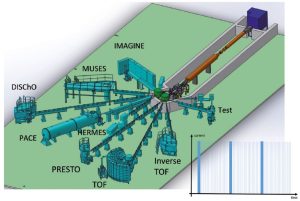Link to the current APiCone COLLABORATIVE CALL FOR PROJECTS
Exploring matter requires probing beams of light (laser photons, X-rays, etc.), neutrons, electrons, or even atoms, molecules or ions. Each type of beam interacts with matter in a very specific way: X-rays are strongly scattered by heavy elements, while neutrons have the great advantage of being strongly scattered by light elements and sensitive to magnetism.
Neutron beams have thus become an important analytical tool for scientists in fields as diverse as condensed matter physics and chemistry, materials science and soft matter, life sciences and geoscience. They are also used as probes in many industrial fields, for materials identification, radiography, validation of radiation resistance, qualification of metallurgical assemblies…

Neutron scattering techniques enable us to probe on extremely large scales, both in terms of size, down to sub-atomic dimensions, and in terms of energy, down to the nano electron volt (see Figure).

The large size and time scales covered by neutron beam studies.
However, neutron sources are not very bright. When large flows of neutrons are required, large-scale infrastructures such as research reactors or spallation sources are currently needed. These facilities produce very large quantities of neutrons (up to 1018 neutrons per second), of which only an infinitesimal fraction is actually used to generate useful beams. This is because neutrons are produced within the nuclear fuel or target in large volumes and emitted in random directions.
In recent years, several institutes, including LLB, have been modeling the ultimate performance of a neutron source whose size could be reduced to a volume of the order of 1 liter (target + moderator). This volume is to be compared with a typical volume of the order of one cubic meter in a research reactor. By reducing the source volume, the brightness of the neutron sources can be greatly increased. Numerical modelling of these compact sources points to potential performances equivalent to those of a research reactor or a medium-power spallation source.
This work points to the construction of a 3rd generation of neutron sources (after research reactors in the 1950s and spallation sources in the 1970s), known as “HiCANS”, for “High-Current Accelerator – driven Neutrons Sources”. These sources would make use of recent developments in low-energy proton gas pedals (a few tens of MeV), which can now operate at proton currents of the order of 100 mA. By scattering on a target, these protons are partially converted into neutrons, which are then moderated in energy (i.e. selected in wavelength) according to the desired experiment. In addition to these advances, other developments include a better understanding of neutron moderation phenomena and new neutron instrumentation techniques to maximize the neutron’s utilization.

Example of a HiCANS neutron scattering facility. The plant has a surface area smaller than a soccer pitch, and an accelerator with a length of 20 to 30 meters.
The aim of these sources is not to achieve ultimate performance, but to build sources that are “accessible” on a national scale, and that do not require the construction of expensive nuclear reactors or high-energy accelerators.
This technological proposal has led to discussions in various research organisms [1]. CEA/DRF, the fundamental research division of the CEA, has been engaged in an R&D program on the subject for several years, in particular around the PHI-Neutrons platform [2]. This work led to the drafting of a project on the proposed construction of a new French neutron scattering source, ICONE, using HiCANS technology [3]. This year, CEA and CNRS launched the drafting of a Detailed Preliminary Project for this project. The facility would serve the French community of neutron technology users, comprising some 1,000 researchers in over 300 French laboratories.
References :
[1] Low-energy accelerator-driven neutrons sources (LENS Report, 2020) ; Compact Accelerator-based Neutron Sources (IAEA TECDOC 1981, 2021)
[2] Les développements instrumentaux peuvent être suivis sur “ICONE : an accelerator-driven neutron source” et “The IPHI-Neutron platform“.
[3] ICONE, une nouvelle source de diffusion neutronique française (2023)
Contact CEA-IRAMIS: Frédéric OTT (LLB/INFRA)
This work is carried out in collaboration with IRFU (Contact: Jérôme Schwindling IRFU/DACM) and the Forschungs Zentrum Jülich (Contact: Paul Zakalek, FZJ, Jülich Center for Neutron Scattering).




